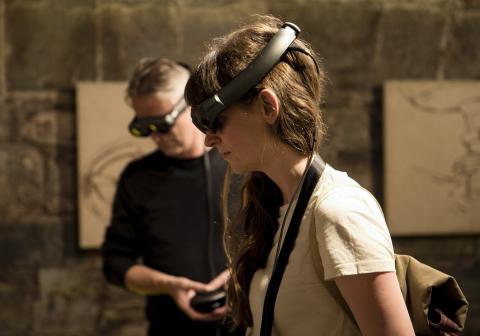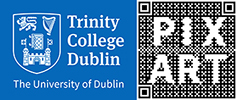
Augmented Play (2019) is the third and final part of the three-year practice-based research trilogy produced under the banner of V-SENSE (lead by (PI) Aljosa Smolic) and directed by Nicholas Johnson. It has much in common with the earlier VR version because it uses the same volumetric video assets, and the mode of user interaction and narrative development is also similar. However, the viewing paradigm is different; they are displayed using the either the Microsoft HoloLens or the Magic Leap augmented reality (AR) head-mounted displays (HMD).
AR is a technology that allows people/audiences to visually merge virtual/graphical/computer-rendered objects with real world objects and scenes, using a mobile phone, a tablet or a head-mounted display (HMD). As opposed to virtual reality, it permits the user to see the world around them; it does not close off the outside world by fully immersing the audience in computerised world. Therefore, AR technology is highly suitable to allowing people to interact with stories at site-specific locations, which means it is ideal for location-based, immersive, role-play and site-specific drama.
The user–narrative paradigm is also the same as the virtual reality version; experiencers are invited to don the AR HMD, embody an interrogator and explore the narrative by confronting virtual reconstructions of Beckett’s characters. The user activates the characters into speaking by looking at them, so the artwork acknowledges the new condition of active audiences and recognises new opportunities for narrative, by affording audiences a central role in its unfurling.
Considering the technology’s suitability for site-specific drama, we launched the in the cavernous vaulted stone basement of the CHQ building which is appropriate to crypt-like, posthumous setting originally envisaged by Beckett. The project has been a resounding success and has received special commendations from the following leading local, national and professional sector media channels:
As a pioneering production of augmented reality drama using VV technology, the project is a ground-breaking milestone for: V-SENSE; Volograms, a domestic SME leading VR, AR and Mixed Reality (MR) technologies for the creative cultural industries; and, the Trinity Centre for Beckett Studies at the Dept. of Drama (TCD), who were pivotal in the production, translation and dramaturgical direction of Beckett’s story.
===============
Credits:
Principal Investigator: Aljosa Smolic
Director: Nicholas Johnson
Producer & Scenographer: Néill O’Dwyer
Post-production: Jan Ondrej, Rafael Pagés, Konstantinos Amplianitis and David Monaghan
Sound Designer: Enda Bates
Actors: Colm Gleeson as M, Maeve O’Mahony as W1, and Caitlin Scott as W2.
The team wishes to thank the Samuel Beckett Estate for permitting the use of Beckett’s original text.
In addition to the primary funding source from Science Foundation Ireland (SFI), this project also received partial funding from the Trinity Visual and Performing Arts Fund, and the Irish Research Council, and The Trinity Long Room Hub Interdisciplinary Seed Funding (2017-18).
